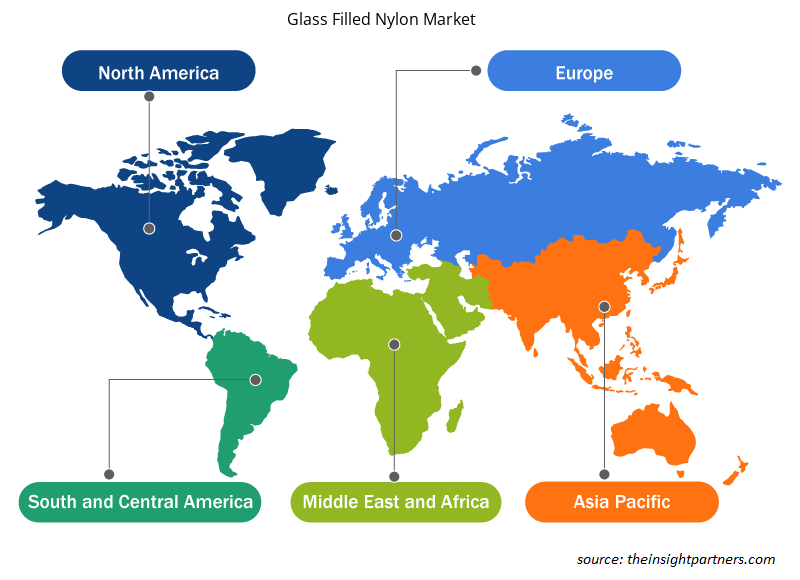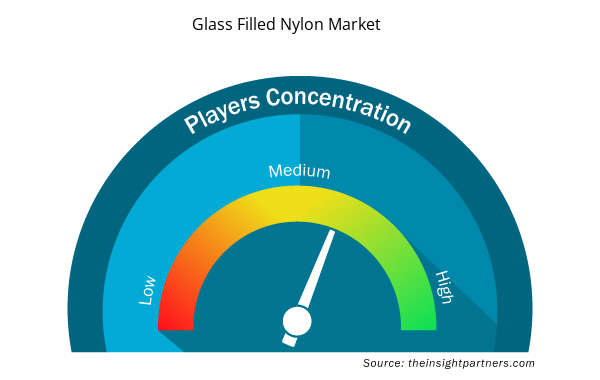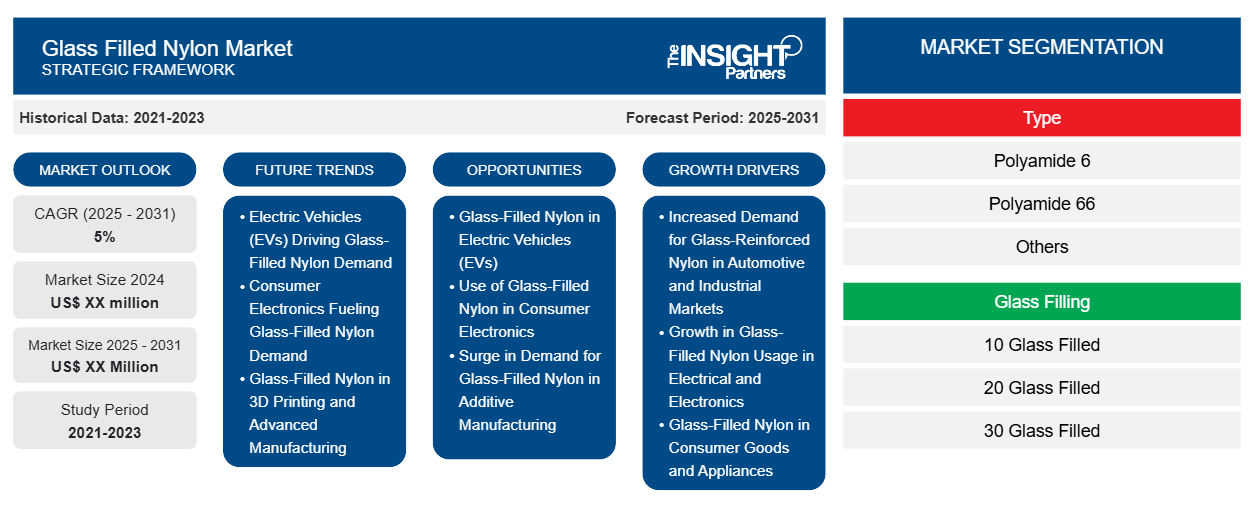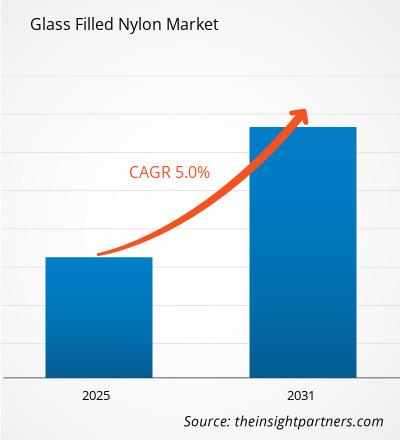ガラス充填ナイロン市場は、 2024年から2031年にかけて5%のCAGRを記録し、市場規模は2024年のXX百万米ドルから2031年にはXX百万米ドルに拡大すると予想されています。
レポートはタイプ別(ポリアミド6、ポリアミド66、その他)に分割されています。グローバル分析は、地域レベルと主要国でさらに細分化されています。レポートではさらに、ガラス充填(10ガラス充填、20ガラス充填、30ガラス充填、30ガラス充填)に基づく分析を示しています。グローバル分析は、地域レベルと主要国でさらに細分化されています。すべての主要な市場セグメントの世界、地域、国レベルでの市場規模と予測がスコープに含まれています。レポートでは、上記の分析とセグメントの値をUSDで提供しています。レポートでは、主要な市場プレーヤーの市場状況に関する重要な統計を提供し、市場の傾向と機会を示しています。
報告書の目的
The Insight Partners のレポート「ガラス充填ナイロン市場」は、現在の状況と将来の成長、主な推進要因、課題、機会を説明することを目的としています。これにより、次のようなさまざまなビジネス関係者に洞察が提供されます。
- テクノロジープロバイダー/メーカー: 進化する市場の動向を理解し、潜在的な成長機会を把握することで、情報に基づいた戦略的意思決定が可能になります。
- 投資家: 市場の成長率、市場の財務予測、バリュー チェーン全体に存在する機会に関する包括的な傾向分析を実施します。
- 規制機関: 市場の濫用を最小限に抑え、投資家の信用と信頼を維持し、市場の完全性と安定性を維持することを目的として、市場における政策と警察活動を規制します。
ガラス繊維入りナイロン市場のセグメンテーション
タイプ
- ポリアミド6
- ポリアミド66
- その他
ガラス充填
- 10 ガラス入り
- 20 ガラス入り
- 30 ガラス入り
- 30 ガラス入り
最終用途産業
- 自動車
- 電気・電子
- 産業
- その他
地理
- 北米
- ヨーロッパ
- アジア太平洋
- 南米と中央アメリカ
- 中東およびアフリカ
要件に合わせてレポートをカスタマイズする
このレポートの一部、国レベルの分析、Excelデータパックなど、あらゆるレポートを無料でカスタマイズできます。また、スタートアップや大学向けのお得なオファーや割引もご利用いただけます。
- このレポートの主要な市場動向を入手してください。この無料サンプルには、市場動向から見積もりや予測に至るまでのデータ分析が含まれます。
ガラス繊維入りナイロン市場の成長要因
- 自動車および工業市場におけるガラス強化ナイロンの需要増加: ガラス強化ナイロンは、強度、剛性、耐熱性などの優れた機械的特性により、自動車および工業市場で需要が増加しています。このような材料は、エンジン、動力伝達に使用される部品、および性能と重量の最小化が重視されるその他の応力支持要素など、自動車業界のさまざまな部分に組み込まれています。
- 電気・電子部品におけるガラス繊維入りナイロンの使用の増加: 電気・電子部品におけるガラス繊維入りナイロンの消費の急速な増加は、市場を刺激する主な要因の 1 つです。このポリマーは優れた絶縁性を備え、強度と耐熱性を兼ね備えているため、コネクタ、スイッチ、ハウジング、回路基板など、信頼性と耐久性が求められる製品に最適です。
- 消費財および家電製品におけるガラス繊維入りナイロン: ガラス繊維入りナイロンは、リーズナブルなコストで製品の品質を高めることができるため、消費財および家電製品で急速に普及しています。この重量最適化により、材料の重量比強度を高く保つことができ、より軽量で強度の高い製品の製造に役立つため、電動工具、家電製品、電子機器の改良に役立っています。
ガラス繊維入りナイロン市場の今後の動向
- 電気自動車 (EV) がガラス繊維入りナイロンの需要を牽引: 電気自動車が主流になりつつある中、自動車業界では、軽量、高強度、耐熱性という特性を持つガラス繊維入りナイロンが急速に採用されるようになるでしょう。性能と持続可能性を追求するため、バッテリー エンクロージャ、モーター部品、電気自動車の構造部品など、ますます多くの部品でガラス繊維入りナイロンが使用されるようになるでしょう。
- ガラス繊維入りナイロンの需要を刺激する家電製品: ウェアラブル機器、モバイル機器、小型電子機器などの家電製品市場は、ガラス繊維入りナイロンの需要を刺激すると予想されており、予測期間中に需要が増加する可能性があります。この素材の優れた電気絶縁特性と強度および靭性は、ポータブル電子機器のハウジングとコネクタのニーズを満たすのに役立ちます。
- 3D 印刷と高度な製造におけるガラス充填ナイロン: 3D 印刷で使用されるガラス充填ナイロンの割合は増加すると予測されています。この材料は機械的強度と寸法安定性に優れ、また積層製造に適用しやすいため、高度なプロトタイプや複雑な部品の製造にも使用できます。時間の経過とともに、技術が 3D ガラス充填産業に向かうにつれて、航空宇宙、自動車、医療などの産業でガラス充填ナイロンがより頻繁に使用されるようになると予測されています。
ガラス繊維入りナイロンの市場機会
- 電気自動車 (EV) におけるガラス繊維入りナイロン: 将来的には、電気自動車が標準になると、特に高強度、耐熱性、断熱性を強化した部品の需要が高まり、ガラス繊維入りナイロン製の部品の需要が高まります。自動車業界がさらなる電動化に向けて準備を進める中、EV のバッテリー エンクロージャ、構造部品、電動モーター部品などの用途は成長が見込まれます。
- 消費者向け電子機器におけるガラス繊維入りナイロンの使用: 消費者向け電子機器業界の拡大に伴い、ガラス繊維入りナイロン複合材は、スマートフォン、ノートパソコン、ウェアラブル、その他の家電製品などのポータブル デバイスでより多くの用途に利用されるようになることは間違いありません。このような素材の強靭性、軽量性、小型で洗練された形状の内部でのサポート能力は、現代の二次経済の成長につながります。
- 積層造形におけるガラス繊維入りナイロンの需要急増: 積層造形や層ごとのデバイス製造において、ガラス繊維入りナイロンは、カスタマイズされた機能部品を製造する傾向が高まっているため、この目的にますます適したものになっています。3D 印刷技術の進化により、ガラス繊維入りナイロンは、自動車やヘルスケアなどの複数の分野にわたるラピッドプロトタイピングや少量生産でますます採用されるようになっています。
ガラス繊維入りナイロン市場の地域別分析
予測期間を通じてガラス繊維入りナイロン市場に影響を与える地域的な傾向と要因は、Insight Partners のアナリストによって徹底的に説明されています。このセクションでは、北米、ヨーロッパ、アジア太平洋、中東、アフリカ、南米、中米にわたるガラス繊維入りナイロン市場のセグメントと地理についても説明します。

- ガラス繊維入りナイロン市場の地域別データを入手
ガラス繊維入りナイロン市場レポートの範囲
| レポート属性 | 詳細 |
|---|---|
| 2024年の市場規模 | XX百万米ドル |
| 2031年までの市場規模 | XX百万米ドル |
| 世界のCAGR(2025年~2031年) | 5% |
| 履歴データ | 2021-2023 |
| 予測期間 | 2025-2031 |
| 対象セグメント | タイプ別
|
| 対象地域と国 | 北米
|
| 市場リーダーと主要企業プロフィール |
|
ガラス充填ナイロン市場のプレーヤー密度:ビジネスダイナミクスへの影響を理解する
ガラス充填ナイロン市場は、消費者の嗜好の変化、技術の進歩、製品の利点に対する認識の高まりなどの要因により、エンドユーザーの需要が高まり、急速に成長しています。需要が高まるにつれて、企業は提供を拡大し、消費者のニーズを満たすために革新し、新たなトレンドを活用し、市場の成長をさらに促進しています。
市場プレーヤー密度とは、特定の市場または業界内で活動している企業または会社の分布を指します。これは、特定の市場スペースに、その規模または総市場価値と比較して、どれだけの競合相手 (市場プレーヤー) が存在するかを示します。
ガラス充填ナイロン市場で事業を展開している主要企業は次のとおりです。
- アルケマグループ
- 旭化成株式会社
- BASF SE
- EI デュポン ドゥ ヌムール アンド カンパニー
- EMS-CHEMIEホールディングAG
免責事項:上記の企業は、特定の順序でランク付けされていません。

- ガラス充填ナイロン市場のトップキープレーヤーの概要を入手
主なセールスポイント
- 包括的なカバレッジ: レポートでは、ガラス充填ナイロン市場の製品、サービス、タイプ、エンドユーザーの分析を包括的にカバーし、全体的な展望を提供します。
- 専門家による分析: レポートは、業界の専門家とアナリストの深い理解に基づいてまとめられています。
- 最新情報: このレポートは、最新の情報とデータの傾向を網羅しているため、ビジネスの関連性を保証します。
- カスタマイズ オプション: このレポートは、特定のクライアント要件に対応し、ビジネス戦略に適切に適合するようにカスタマイズできます。
したがって、ガラス充填ナイロン市場に関する調査レポートは、業界のシナリオと成長の見通しを解読し理解する道の先導役となることができます。いくつかの正当な懸念があるかもしれませんが、このレポートの全体的な利点は欠点を上回る傾向があります。
- 過去2年間の分析、基準年、CAGRによる予測(7年間)
- PEST分析とSWOT分析
- 市場規模価値/数量 - 世界、地域、国
- 業界と競争環境
- Excel データセット


- Hand Sanitizer Market
- Artificial Intelligence in Healthcare Diagnosis Market
- Europe Industrial Chillers Market
- Single Pair Ethernet Market
- 3D Audio Market
- Authentication and Brand Protection Market
- Flexible Garden Hoses Market
- Diaper Packaging Machine Market
- Military Rubber Tracks Market
- Carbon Fiber Market

Report Coverage
Revenue forecast, Company Analysis, Industry landscape, Growth factors, and Trends

Segment Covered
This text is related
to segments covered.

Regional Scope
North America, Europe, Asia Pacific, Middle East & Africa, South & Central America

Country Scope
This text is related
to country scope.
よくある質問
Increase in demand from electric vehicles (EVs) is expected to be the key market trends
Based on type, the polyamide 66 segment is expected to witness the fastest growth during the forecast period
Based on geography, Asia Pacific held the largest share of the glass filled nylon market due to the well-established automotive industry across the region, coupled with continuous growth and development
Rising demand for high-performance materials in automotive and industrial applications is driving the market growth
DuPont de Nemours, Inc.
; BASF SE
; Solvay
; LANXESS AG
; DSM Engineering Materials
; Toray Industries, Inc.
; Ascend Performance Materials
; Clariant International Ltd.
; Evonik Industries AG
; PolyOne Corporation
; SABIC
; 3M Company
; Mitsui Chemicals, Inc.
; Kraton Polymers
; Huntsman Corporation
The Glass Filled Nylon Market is estimated to witness a CAGR of 5% from 2023 to 2031
Trends and growth analysis reports related to Chemicals and Materials : READ MORE..
1.Arkema Group
2.Asahi Kasei Corporation
3.BASF SE
4.E. I. du Pont de Nemours and Company
5.EMS-CHEMIE HOLDING AG
6.Evonik Industries
7.Lanxess
8.Royal DSM N.V.
9.RTP Company
10.SABIC
The Insight Partners performs research in 4 major stages: Data Collection & Secondary Research, Primary Research, Data Analysis and Data Triangulation & Final Review.
- Data Collection and Secondary Research:
As a market research and consulting firm operating from a decade, we have published and advised several client across the globe. First step for any study will start with an assessment of currently available data and insights from existing reports. Further, historical and current market information is collected from Investor Presentations, Annual Reports, SEC Filings, etc., and other information related to company’s performance and market positioning are gathered from Paid Databases (Factiva, Hoovers, and Reuters) and various other publications available in public domain.
Several associations trade associates, technical forums, institutes, societies and organization are accessed to gain technical as well as market related insights through their publications such as research papers, blogs and press releases related to the studies are referred to get cues about the market. Further, white papers, journals, magazines, and other news articles published in last 3 years are scrutinized and analyzed to understand the current market trends.
- Primary Research:
The primarily interview analysis comprise of data obtained from industry participants interview and answers to survey questions gathered by in-house primary team.
For primary research, interviews are conducted with industry experts/CEOs/Marketing Managers/VPs/Subject Matter Experts from both demand and supply side to get a 360-degree view of the market. The primary team conducts several interviews based on the complexity of the markets to understand the various market trends and dynamics which makes research more credible and precise.
A typical research interview fulfils the following functions:
- Provides first-hand information on the market size, market trends, growth trends, competitive landscape, and outlook
- Validates and strengthens in-house secondary research findings
- Develops the analysis team’s expertise and market understanding
Primary research involves email interactions and telephone interviews for each market, category, segment, and sub-segment across geographies. The participants who typically take part in such a process include, but are not limited to:
- Industry participants: VPs, business development managers, market intelligence managers and national sales managers
- Outside experts: Valuation experts, research analysts and key opinion leaders specializing in the electronics and semiconductor industry.
Below is the breakup of our primary respondents by company, designation, and region:

Once we receive the confirmation from primary research sources or primary respondents, we finalize the base year market estimation and forecast the data as per the macroeconomic and microeconomic factors assessed during data collection.
- Data Analysis:
Once data is validated through both secondary as well as primary respondents, we finalize the market estimations by hypothesis formulation and factor analysis at regional and country level.
- Macro-Economic Factor Analysis:
We analyse macroeconomic indicators such the gross domestic product (GDP), increase in the demand for goods and services across industries, technological advancement, regional economic growth, governmental policies, the influence of COVID-19, PEST analysis, and other aspects. This analysis aids in setting benchmarks for various nations/regions and approximating market splits. Additionally, the general trend of the aforementioned components aid in determining the market's development possibilities.
- Country Level Data:
Various factors that are especially aligned to the country are taken into account to determine the market size for a certain area and country, including the presence of vendors, such as headquarters and offices, the country's GDP, demand patterns, and industry growth. To comprehend the market dynamics for the nation, a number of growth variables, inhibitors, application areas, and current market trends are researched. The aforementioned elements aid in determining the country's overall market's growth potential.
- Company Profile:
The “Table of Contents” is formulated by listing and analyzing more than 25 - 30 companies operating in the market ecosystem across geographies. However, we profile only 10 companies as a standard practice in our syndicate reports. These 10 companies comprise leading, emerging, and regional players. Nonetheless, our analysis is not restricted to the 10 listed companies, we also analyze other companies present in the market to develop a holistic view and understand the prevailing trends. The “Company Profiles” section in the report covers key facts, business description, products & services, financial information, SWOT analysis, and key developments. The financial information presented is extracted from the annual reports and official documents of the publicly listed companies. Upon collecting the information for the sections of respective companies, we verify them via various primary sources and then compile the data in respective company profiles. The company level information helps us in deriving the base number as well as in forecasting the market size.
- Developing Base Number:
Aggregation of sales statistics (2020-2022) and macro-economic factor, and other secondary and primary research insights are utilized to arrive at base number and related market shares for 2022. The data gaps are identified in this step and relevant market data is analyzed, collected from paid primary interviews or databases. On finalizing the base year market size, forecasts are developed on the basis of macro-economic, industry and market growth factors and company level analysis.
- Data Triangulation and Final Review:
The market findings and base year market size calculations are validated from supply as well as demand side. Demand side validations are based on macro-economic factor analysis and benchmarks for respective regions and countries. In case of supply side validations, revenues of major companies are estimated (in case not available) based on industry benchmark, approximate number of employees, product portfolio, and primary interviews revenues are gathered. Further revenue from target product/service segment is assessed to avoid overshooting of market statistics. In case of heavy deviations between supply and demand side values, all thes steps are repeated to achieve synchronization.
We follow an iterative model, wherein we share our research findings with Subject Matter Experts (SME’s) and Key Opinion Leaders (KOLs) until consensus view of the market is not formulated – this model negates any drastic deviation in the opinions of experts. Only validated and universally acceptable research findings are quoted in our reports.
We have important check points that we use to validate our research findings – which we call – data triangulation, where we validate the information, we generate from secondary sources with primary interviews and then we re-validate with our internal data bases and Subject matter experts. This comprehensive model enables us to deliver high quality, reliable data in shortest possible time.


 このレポートの無料サンプルを入手する
このレポートの無料サンプルを入手する